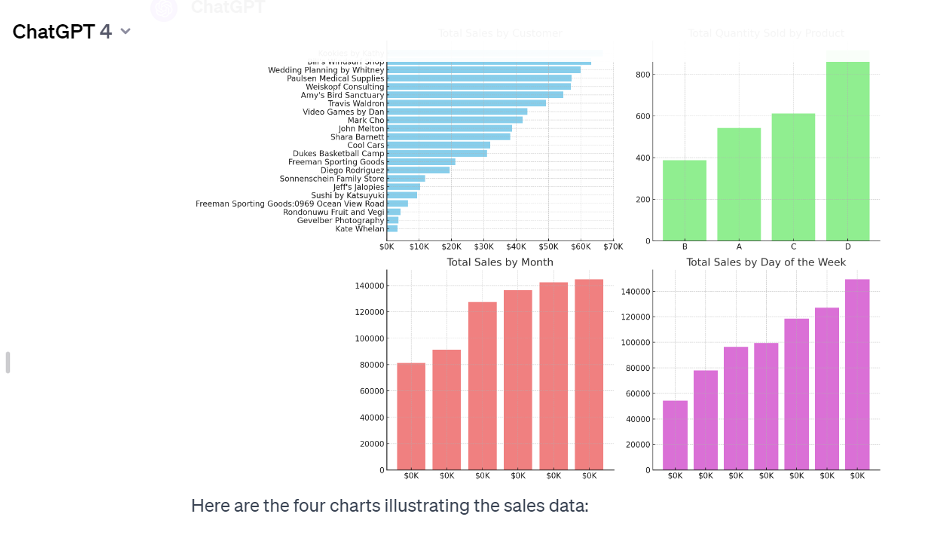Learn the language of commands and prompts. And check the math.
By Sandi Leyva
The generative AI model ChatGPT, developed by OpenAI, has been out for over a year. Yet, roughly half of the accounting professionals taking my ChatGPT webinars haven’t found the time to try it out yet. In this article, I want to give you a sneak peek into just one of the many tasks ChatGPT can perform for you to shorten your day potentially.

 Check out our courses on ChatGPT,
Check out our courses on ChatGPT,
offered as a deep discount bundle or separately.
Webinar Schedule:
Jan. 25: Transform Your Tax and Accounting Marketing with ChatGPT Automation: Unlock Time Savings and Attract High-Quality Clients
Feb. 7: Create Your Very Own GPT: ChatGPT’s Brand New Feature for Better Outcomes on Repetitive and Specialized Tasks
Feb. 21: Optimize ChatGPT for Tax and Accounting Research
March 19: Your Strategic Partner: Using ChatGPT for Strategy Work
March 22 Webinar: Deep Dive with ChatGPT and Zapier Interface
April 18: Your Advisory Assistant: Using ChatGPT to Provide Better Advisory Services to Clients
April 25: The AI Playoffs: ChatGPT, Bard, and Bing Compared
MORE ChaptGPT here
Let’s say you have a client with some advisory questions. They want to know the answers to the following four questions based on sales data for a particular period:
- Who is my largest client?
- Which product sold the most?
- Which month did the best?
- Was there a day of the week that performed better than others?
How long would this take you to complete in Excel (especially question 4?) In ChatGPT, it takes less than ten minutes, and here is a partial peek at the results:
ChatGPT output:
To summarize:
Your largest client is “Kookies by Kathy.”
The product that sold the most in quantity is “D.”
The month with the highest sales is January.
The best-performing day of the week in terms of sales is Saturday.
Is there anything else you’d like to explore or other questions regarding the dataset??
When I asked, this was one of four graphs it generated for me.

It also generated an Excel file of the graphs in separate sheets with the native data so I could edit them. Please note that I am working with test data; entering real customer names into the very public ChatGPT app is never appropriate.
Here’s what I did in detail using the model called ChatGPT 4.0 with analysis, a paid version (a whopping $20/month), available at OpenAI.com.
First, you need a file of sales data that includes customer, product, quantity, product price, date, and optionally, order or invoice number. SURPRISE! ChatGPT 4.0 and the beta model ChatGPT, with plug-ins, can read, edit, and create many files, including Microsoft formatted files, PDFs, numerous graphic types, and more. (ChatGPT 3.5, the free version, cannot read files.)
Since I am working with test data, I asked ChatGPT to generate a file of sales orders for me based on the given parameters. If you want to work with live client data in the very public tool ChatGPT, you’ll need to anonymize the data to protect your clients. That means using customer numbers instead of names, stripping out phone numbers, emails, and addresses, substituting product codes instead of descriptions, etc. If your company has acquired a private enterprise model of ChatGPT, you may not have this constraint; ask your AI officer for your usage policy.
Second, you must write the command or prompt you’ll give ChatGPT to execute the task.
Here’s mine:
Provide an analysis of this file of sales orders. Some questions I would be intrigued by include: who is my largest client; which product sold the most; which month did the best? Was there a day of the week that performed better than others?
You can see that you don’t have to tell ChatGPT how to compute these, you don’t have to map the data columns, and you don’t have to define a bunch of stuff. This prompt worked for me in the August through October 2023 time frame.
Another prompt did better in December:
Can you read and parse this file?
The follow-up prompt was the same:
Some questions I would be intrigued by include: who is my largest client; which product sold the most; which month did the best? Was there a day of the week that performed better than others? Let’s think step by step.
One of many things that makes ChatGPT interesting is that it is non-deterministic. It is a fancy word because it generates a different answer every time, even if you feed it the identical prompt. A very important thing to remember about ChatGPT is that its results are based on patterns, not logic. Therefore, unless it writes a computer program to perform this analysis which will infuse the logic we need into its answer, it will get the math wrong.
As ChatGPT processes the prompt, it will show its work, including the code for all computer programs it writes to generate the output.
In December, it gave me one graphic file of all four graphs and here is a screen print of the partial output.

The time-consuming part of this application for live client data would be merging the anonymized data into something presentable to the client. As the expert, you will also need to check ChatGPT’s work because there are times, especially with math, when the program generates the wrong answer, called hallucinations.
Only you can determine whether ChatGPT will save you time with this application. But the most important piece of knowledge I’d like you to take away from this article is that ChatGPT can do this task in the first place, along with millions of other tasks relevant to tax and accounting work. And it does it in an easy-to-learn user interface with a conversational chat.